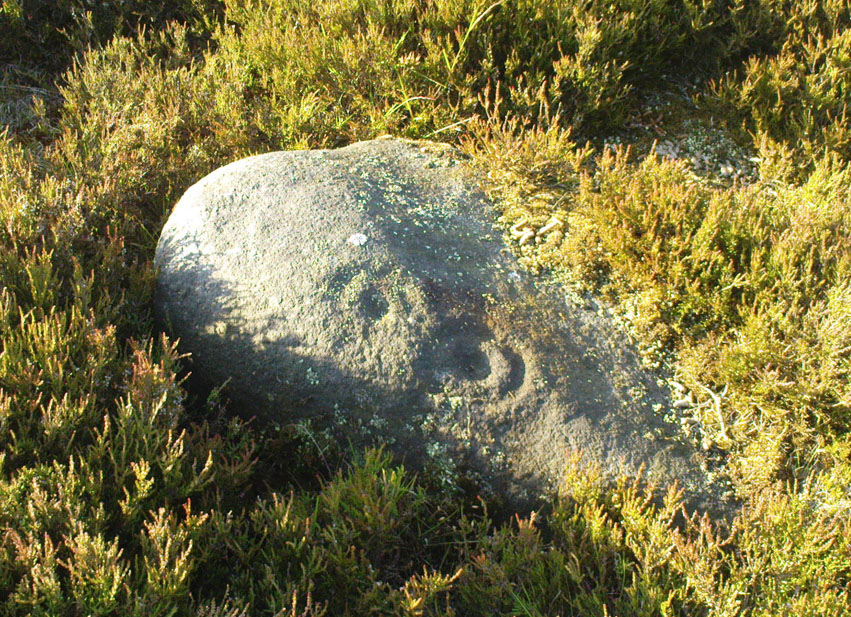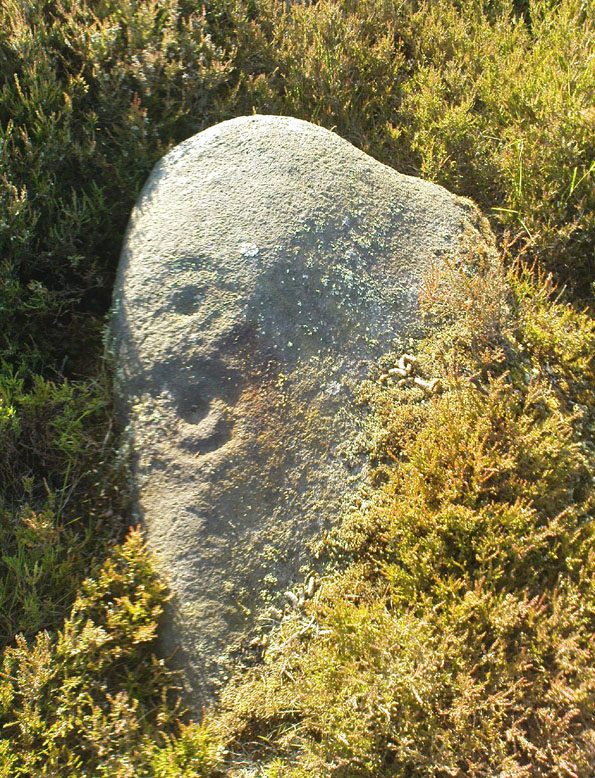Cup-Marked Stone: OS Grid Reference – SE 1411 5431
Also Known as:
- Owl Stone
- Sunset Stone

Same directions as the Slade 01 carving. But once you reach the upstanding stone cairn on the rocky hill, walk 220 yards (less than 200m) WSW and look around. You’re damn close! If you find the large cup-marked Slade 03 carving, walk back east about 10-20 yards and you can’t really miss it!
Archaeology & History
This is just one of at least seven previously undiscovered carvings on this section of moorland – and it’s worth looking for! The two other names we gave it — ‘owl’ and ‘sunset’ — come from the very notable design: owl thanks to it having the appearance of large owl-like eyes, and sunset as the two cup-and-rings are etched on the western edge of the rock and, when we found it yesterday, the sun was setting (albeit to the NW) and the image prompted talks of setting suns, the land of the Dead and other such worldwide indigenous religious myths (Harvey 2000) — for without recourse to such ingredients, these carvings are vacuous archaeocentric museum pieces and nothing more. And this carving at least deserves much more than mere cataloguing! The internationally renowned archaeologist, O.G.S. Crawford (1957) would have entered this carving into his ‘eye’ and ‘owl’ motif, representative of goddesses or spirit-forms, as would Gimbutas. (1989)

But this carving is archetypal, as we can see, though would appear to have no other etched features on the stone’s surface. It is very close (if not within) the prehistoric graveyard that is plainly evident 30-40 yards south in the burnt heather and would very likely have had some mythic relationship with the dead (a symbiosis we have found in many cup-and-rings). We plan further ventures here in the coming weeks in the hope that we can unearth other prehistoric remains.
References:
- Crawford, O.G.S., The Eye Goddess, Phoenix House: London 1957.
- Gimbutas, Marija, The Language of the Goddess, Harper Collins: New York 1989.
- Harvey, Graham (ed.), Indigenous Religions, Cassell: London 2000.
© Paul Bennett, The Northern Antiquarian
The map could not be loaded. Please contact the site owner.
I took a photo of this stone late evening as the summer sun was slowly falling to setting position,but still way above the horizon, and got an eerie looking image of a skull to be honest due to two eyes showing up and the lower ring appearing as an open smiley mouth:-)
In fact if you look at the top photo above, you can just make out another ring above the one on the left hand side, and this one on my photo appears more clearly, while the lower ring appears to be more central from the angle that I photographed it, with the slight ridge beneath posing as a nose!
This positioning of the rings reminds me of Long Meg which I recently visited in Keswick where at the bottom left there are two concentric circles that are carved one vertically above the other, while at the top left of the stone two circles are placed side by side.
Hi Tricia! – I think you’re right – a second faint incomplete ring may indeed be on this. I was up here t’other week & had a gander over to look at it again (and also found another 4 undiscovered cup-and-rings, about a mile away).